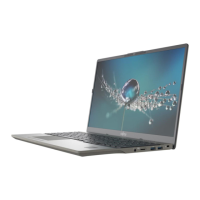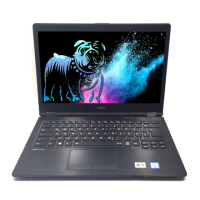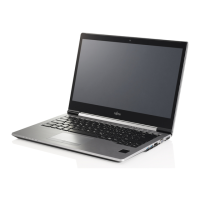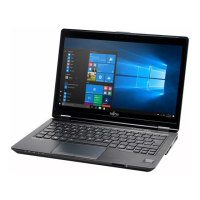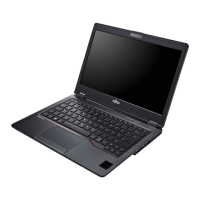Do you have a question about the Fujitsu LIFEBOOK U7410 and is the answer not in the manual?
Provides links to online resources for drivers, tips, and software information.
Identifies and describes the front-facing hardware components and indicators of the notebook.
Lists and describes the ports and connectors located on the left side of the notebook.
Lists and describes the ports and connectors located on the right side of the notebook.
Lists and describes the ports and connectors located on the bottom of the notebook.
Provides essential safety information and warnings for operating the notebook safely.
Details safety precautions for using wireless components like Wi-Fi and Bluetooth.
Offers advice on conserving battery power and improving energy efficiency.
Provides essential information and precautions for traveling with the notebook.
Explains the correct procedures and precautions for cleaning the notebook.
Guides users through unpacking the device and checking for any transit damage.
Provides guidelines for choosing a suitable and safe location to set up the device.
Details the procedure for connecting the mains adapter and power supply.
Explains the initial power-on sequence and software installation process.
Explains the meaning and function of the various status indicators on the notebook.
Describes the procedure for powering on and shutting down the notebook.
Covers keyboard layout, special keys, and function key combinations.
Explains the virtual numeric keypad functionality and layout.
Describes the separate numeric keypad on the right side of the keyboard.
Details the functionality of function keys and common key combinations.
Explains how to configure the F-Lock setting for function keys.
Describes the operation and settings for the keyboard background lighting.
Details the use and maintenance of the touchpad and its buttons.
Explains LCD screen resolution, pixel structure, and potential display imperfections.
Guides on using finger gestures for interaction on the touchscreen.
Describes the functionality and usage of the integrated Webcam and Infrared Camera.
Provides information on battery life, care, charging, and storage.
Explains the step-by-step procedure for removing and installing the notebook battery.
Guides on utilizing power-management features to conserve battery life.
Explains how to adjust fan control settings via BIOS Setup Utility or Function Manager.
Details supported memory card formats, insertion, and removal.
Describes the location and usage of built-in speakers and microphones.
Explains SIM card usage, types supported, and eSIM functionality.
Provides instructions for inserting and removing a SIM card into the notebook.
Covers installation and safety of wireless components like Wi-Fi, Bluetooth, and LTE.
Explains how to enable or disable wireless components and flight mode.
Guides on configuring wireless LAN access.
Details how to connect to the internet using an LTE module.
Explains how to establish a connection to a local network using Ethernet LAN.
Introduces the Port Replicator and its function for connecting peripherals.
Identifies and describes the various ports available on the Port Replicator.
Provides step-by-step instructions for docking the notebook to the Port Replicator.
Details how to connect the mains adapter to the Port Replicator.
Explains how to power on the notebook using the Port Replicator's button.
Provides step-by-step instructions for undocking the notebook from the Port Replicator.
Guides on setting up and using the fingerprint sensor for authentication.
Explains how to set up and use the palm vein sensor for authentication.
Details how to use the Kensington Lock Cable to protect the notebook from theft.
Provides instructions for setting up BIOS passwords for enhanced data security.
Explains the roles of supervisor and user passwords for BIOS access control.
Guides on creating supervisor and user passwords for BIOS access.
Details the procedure for removing BIOS supervisor and user passwords.
Explains how to enable password protection for the operating system boot process.
Details how to set up password protection for the hard disk drive.
Explains the activation and deactivation of the Trusted Platform Module (TPM).
Guides on how to enable and disable the TPM security feature.
Describes the SmartCard reader functionality and supported standards.
Provides instructions for inserting and removing a SmartCard into the reader.
Guides on connecting external monitors via VGA, DVI-D, and HDMI ports.
Explains how to connect various USB devices and their data transfer rates.
Details the features and usage of the USB Type-C port, including charging and display.
Explains the Anytime USB charge function for powering external devices.
Guides on safely disconnecting USB devices to prevent data loss.
Describes the connection and usage of the headset port for audio devices.
Provides essential safety notes and precautions for handling internal components.
Details the necessary preliminary steps before removing any system components.
Guides on installing and removing memory modules for expansion.
Explains how to safely remove the notebook's outer cover.
Provides step-by-step instructions for removing memory modules.
Details the procedure for installing a new memory module.
Guides on how to reattach the notebook cover after servicing.
Explains the process for installing and removing M.2 storage modules.
Details the procedure for installing an M.2 module.
Provides step-by-step instructions for removing an M.2 module.
Outlines the final steps to prepare the device for operation after component changes.
Explains how to access and start the BIOS Setup Utility program.
Provides guidance on navigating and configuring settings within the BIOS Setup Utility.
Details the options for saving changes, discarding them, or loading defaults.
Explains the Erase Disk function for securely deleting data from hard disks or SSDs.
Provides steps to take when encountering problems and how to contact support.
Guides on reinstalling the operating system using recovery media.
Explains how to reset the system to its original state via Windows settings.
Troubleshooting steps for incorrect system date and time settings.
Addresses an issue where only numerals are typed when specific keys are pressed.
Troubleshooting steps for a blank or unresponsive LCD screen.
Offers solutions for poor LCD screen visibility, such as glare or low brightness.
Troubleshooting steps for an external monitor that remains blank or unstable.
Guides on troubleshooting when the notebook fails to power on.
Troubleshooting steps for when the notebook becomes unresponsive or stops working.
Provides solutions for problems related to the printer not printing.
Troubleshooting steps for issues with wireless network connectivity.
Guides on troubleshooting when the SmartCard reader is not recognized.
Provides guidance on what to do if the SmartCard PIN is forgotten.
Offers advice on actions to take if a SmartCard is lost.
Explains common error messages and their resolutions.
Lists the operating and transit temperature, humidity, and height specifications.
Provides the physical dimensions (width, depth, height) and weight of the notebooks.
Details the notebook's main memory slots and approved memory modules.
Lists specifications for the notebook's rechargeable battery, including voltage and capacity.
Provides electrical specifications for the notebook's mains adapter.
Details the electrical specifications for the Port Replicator's mains adapter.
Provides information on the proper disposal and recycling of the notebook and its battery.
Mentions TCO certification and where to find more information.
Indicates where to find additional certification markings and supplements.
Provides links to online resources for drivers, tips, and software information.
Identifies and describes the front-facing hardware components and indicators of the notebook.
Lists and describes the ports and connectors located on the left side of the notebook.
Lists and describes the ports and connectors located on the right side of the notebook.
Lists and describes the ports and connectors located on the bottom of the notebook.
Provides essential safety information and warnings for operating the notebook safely.
Details safety precautions for using wireless components like Wi-Fi and Bluetooth.
Offers advice on conserving battery power and improving energy efficiency.
Provides essential information and precautions for traveling with the notebook.
Explains the correct procedures and precautions for cleaning the notebook.
Guides users through unpacking the device and checking for any transit damage.
Provides guidelines for choosing a suitable and safe location to set up the device.
Details the procedure for connecting the mains adapter and power supply.
Explains the initial power-on sequence and software installation process.
Explains the meaning and function of the various status indicators on the notebook.
Describes the procedure for powering on and shutting down the notebook.
Covers keyboard layout, special keys, and function key combinations.
Explains the virtual numeric keypad functionality and layout.
Describes the separate numeric keypad on the right side of the keyboard.
Details the functionality of function keys and common key combinations.
Explains how to configure the F-Lock setting for function keys.
Describes the operation and settings for the keyboard background lighting.
Details the use and maintenance of the touchpad and its buttons.
Explains LCD screen resolution, pixel structure, and potential display imperfections.
Guides on using finger gestures for interaction on the touchscreen.
Describes the functionality and usage of the integrated Webcam and Infrared Camera.
Provides information on battery life, care, charging, and storage.
Explains the step-by-step procedure for removing and installing the notebook battery.
Guides on utilizing power-management features to conserve battery life.
Explains how to adjust fan control settings via BIOS Setup Utility or Function Manager.
Details supported memory card formats, insertion, and removal.
Describes the location and usage of built-in speakers and microphones.
Explains SIM card usage, types supported, and eSIM functionality.
Provides instructions for inserting and removing a SIM card into the notebook.
Covers installation and safety of wireless components like Wi-Fi, Bluetooth, and LTE.
Explains how to enable or disable wireless components and flight mode.
Guides on configuring wireless LAN access.
Details how to connect to the internet using an LTE module.
Explains how to establish a connection to a local network using Ethernet LAN.
Introduces the Port Replicator and its function for connecting peripherals.
Identifies and describes the various ports available on the Port Replicator.
Provides step-by-step instructions for docking the notebook to the Port Replicator.
Details how to connect the mains adapter to the Port Replicator.
Explains how to power on the notebook using the Port Replicator's button.
Provides step-by-step instructions for undocking the notebook from the Port Replicator.
Guides on setting up and using the fingerprint sensor for authentication.
Explains how to set up and use the palm vein sensor for authentication.
Details how to use the Kensington Lock Cable to protect the notebook from theft.
Provides instructions for setting up BIOS passwords for enhanced data security.
Explains the roles of supervisor and user passwords for BIOS access control.
Guides on creating supervisor and user passwords for BIOS access.
Details the procedure for removing BIOS supervisor and user passwords.
Explains how to enable password protection for the operating system boot process.
Details how to set up password protection for the hard disk drive.
Explains the activation and deactivation of the Trusted Platform Module (TPM).
Guides on how to enable and disable the TPM security feature.
Describes the SmartCard reader functionality and supported standards.
Provides instructions for inserting and removing a SmartCard into the reader.
Guides on connecting external monitors via VGA, DVI-D, and HDMI ports.
Explains how to connect various USB devices and their data transfer rates.
Details the features and usage of the USB Type-C port, including charging and display.
Explains the Anytime USB charge function for powering external devices.
Guides on safely disconnecting USB devices to prevent data loss.
Describes the connection and usage of the headset port for audio devices.
Provides essential safety notes and precautions for handling internal components.
Details the necessary preliminary steps before removing any system components.
Guides on installing and removing memory modules for expansion.
Explains how to safely remove the notebook's outer cover.
Provides step-by-step instructions for removing memory modules.
Details the procedure for installing a new memory module.
Guides on how to reattach the notebook cover after servicing.
Explains the process for installing and removing M.2 storage modules.
Details the procedure for installing an M.2 module.
Provides step-by-step instructions for removing an M.2 module.
Outlines the final steps to prepare the device for operation after component changes.
Explains how to access and start the BIOS Setup Utility program.
Provides guidance on navigating and configuring settings within the BIOS Setup Utility.
Details the options for saving changes, discarding them, or loading defaults.
Explains the Erase Disk function for securely deleting data from hard disks or SSDs.
Provides steps to take when encountering problems and how to contact support.
Guides on reinstalling the operating system using recovery media.
Explains how to reset the system to its original state via Windows settings.
Troubleshooting steps for incorrect system date and time settings.
Addresses an issue where only numerals are typed when specific keys are pressed.
Troubleshooting steps for a blank or unresponsive LCD screen.
Offers solutions for poor LCD screen visibility, such as glare or low brightness.
Troubleshooting steps for an external monitor that remains blank or unstable.
Guides on troubleshooting when the notebook fails to power on.
Troubleshooting steps for when the notebook becomes unresponsive or stops working.
Provides solutions for problems related to the printer not printing.
Troubleshooting steps for issues with wireless network connectivity.
Guides on troubleshooting when the SmartCard reader is not recognized.
Provides guidance on what to do if the SmartCard PIN is forgotten.
Offers advice on actions to take if a SmartCard is lost.
Explains common error messages and their resolutions.
Lists the operating and transit temperature, humidity, and height specifications.
Provides the physical dimensions (width, depth, height) and weight of the notebooks.
Details the notebook's main memory slots and approved memory modules.
Lists specifications for the notebook's rechargeable battery, including voltage and capacity.
Provides electrical specifications for the notebook's mains adapter.
Details the electrical specifications for the Port Replicator's mains adapter.
Provides information on the proper disposal and recycling of the notebook and its battery.
Mentions TCO certification and where to find more information.
Indicates where to find additional certification markings and supplements.
| RAM | 8GB DDR4 |
|---|---|
| Storage | 256GB SSD |
| Display | 1920x1080 |
| Operating System | Windows 10 Pro |
| Webcam | HD webcam |
| Dimensions | 19.9 mm |
| Audio | Stereo speakers |
| Ports | HDMI |
| Wireless | Wi-Fi 802.11ac |
